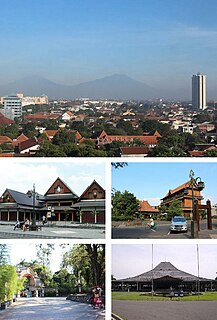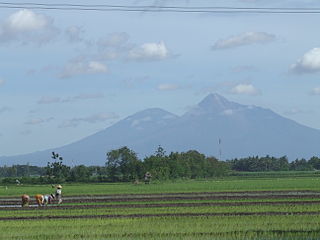
Gamelan is the traditional ensemble music of Java and Bali in Indonesia, made up predominantly of percussive instruments. The most common instruments used are metallophones played by mallets and a set of hand-played drums called kendhang which register the beat. Also the kemanak, a banana shaped idiophone and gangsa, another metallaphone are amongst the commonly used gamelan instruments. Other instruments include xylophones, bamboo flutes, a bowed instrument called a rebab, and even vocalists called sindhen.

The music of Indonesia demonstrates its cultural diversity, the local musical creativity, as well as subsequent foreign musical influences that shaped contemporary music scenes of Indonesia. Nearly thousands of Indonesian islands having its own cultural and artistic history and character. This results in hundreds of different forms of music, which often accompanies by dance and theatre.
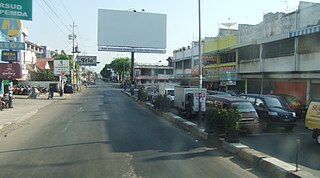
Pekalongan is a city of Central Java, Indonesia. It was formerly the seat of Pekalongan Regency on the northern coast of the province, but is now an independent municipality within the province. The city is Central Java's most important port, and is known for its batik. Since December 2014, Pekalongan is a member of UNESCO’s World’s Creative Cities Network. Pekalongan is the first Indonesian city and first South East Asian city listed as member of UNESCO’s World’s Creative Cities Network

Jody Diamond is an American composer, performer, writer, publisher, editor, and educator. She specializes in traditional and new music for Indonesian gamelan and is active internationally as a scholar, performer, and publisher.
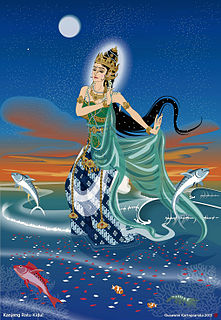
Nyai Loro Kidul is an Indonesian goddess of the sea. She is the Queen of the Southern Sea in Javanese and Sundanese mythology.
Sumarsam is a Javanese musician and scholar of the gamelan.
Kroncong is the name of a ukulele-like instrument and an Indonesian musical style that typically makes use of the kroncong, the band or combo or ensemble consists of a flute, a violin, a melody guitar, a cello in pizzicato style, string bass in pizzicato style, and a female or male singer.
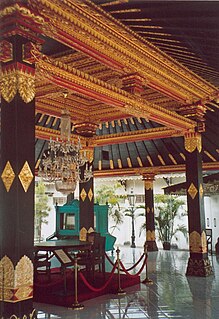
Javanese culture is the culture of the Javanese ethnic group in Indonesia, part of the Indonesian culture. Javanese culture is centered in the Central Java, Yogyakarta and East Java provinces of Indonesia. Due to various migrations, it can also be found in other parts of the world, such as Suriname, the broader Indonesian archipelago region, Cape Malay, Malaysia, Singapore, Netherlands and other countries. The migrants bring with them various aspects of Javanese cultures such as Gamelan music, traditional dances and art of Wayang kulit shadow play.

A blangkon or belangkon (Indonesian) is a traditional Javanese headdress worn by men and made of batik fabric. There are four types of blangkons, distinguished by their shapes and origins: Ngayogyakarta, Surakarta, Kedu, and Banyumasan.
Nurhayati Srihardini Siti Nukatin, better known by her pen name Nh. Dini, was an Indonesian novelist and feminist. She was the youngest of five children of Saljowidjojo and Kusaminah. One branch of the family can be traced back to the Bugis of South Sulawesi.

The national costume of Indonesia is the national costume that represents the Republic of Indonesia. It is derived from Indonesian culture and Indonesian traditional textile traditions. Today the most widely recognized Indonesian national costumes include batik and kebaya, although originally those costumes mainly belong within the culture of Java and Bali, most prominently within Javanese, Sundanese and Balinese culture. Since Java has been the political and population center of Indonesia, folk costume from the island has become elevated into national status.
Atilah Soeryadjaya is an Indonesian theatre producer, director, dancer, businesswoman, and socialite whose career spanned since 2010. She is the Javanese noblewoman through her grandfather, a Surakarta-based Javanese king, Mangkunegara VII. She is married to the business tycoon, Edward Soeryadjaya, son of the founder of Astra International, William Soeryadjaya.

The Great Mosque of Surakarta is an 18th-century Javanese mosque in Surakarta, Central Java, Indonesia. It is the royal mosque of the Surakarta Sunanate.
Detty Kurnia was an Indonesian vocalist who sang Pop Sunda by blending traditional Indonesian music with western music. She started singing at a young age, and released her record at the age of 11. Under a recording contract with Japanese Wave Records, in the year 1991 she recorded the album, Dari Sunda. She also released the album the Rough Guide to the Music of Indonesia. She was an iconic singer in the well known Indonesian musical genre of dangdut a folk and traditional music. Her song Dari Sunda in the Pop Sunda-style was among the five best albums listed by Q Magazine and acclaimed as "an imaginative, inventive gem throughout with Kurnia's mellow smile of a voice effortlessly binding everything together."
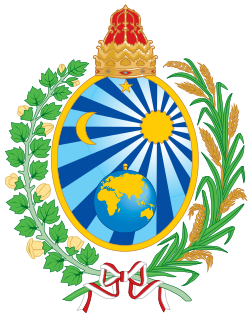
Mooryati Soedibyo, also known as Hj. DR. BRA. Mooryati Soedibyo, S.S., M. Hum., is a member of Indonesian Highest Royal Family - Monarch of Surakarta Sunanate, president director of Mustika Ratu and the Vice Chairman II of the People's Consultative Assembly of the Republic of Indonesia, also serving as the national director of Indonesia for franchise of Miss Universe Indonesia as known as Puteri Indonesia Org., which hold the license of Indonesian representative at Miss Universe, Miss International and Miss Supranational. She's also ranked number 7 on the list of the 99 most influential women in Indonesia 2007 by the Globe Asia magazine. Mooryati Soedibyo was recorded by MURI-Indonesian World Records Museum as the winner of the oldest doctorate in Indonesia, and as "Empu Jamu".


